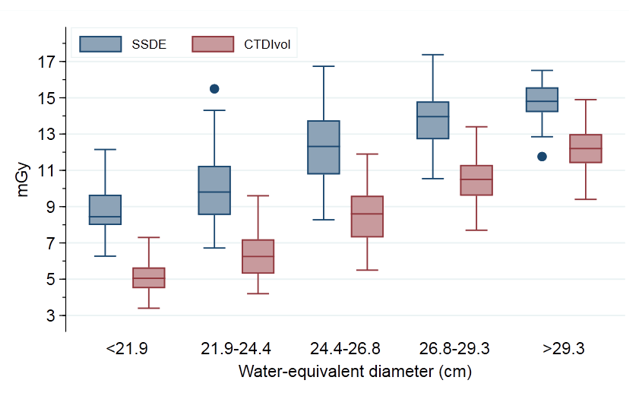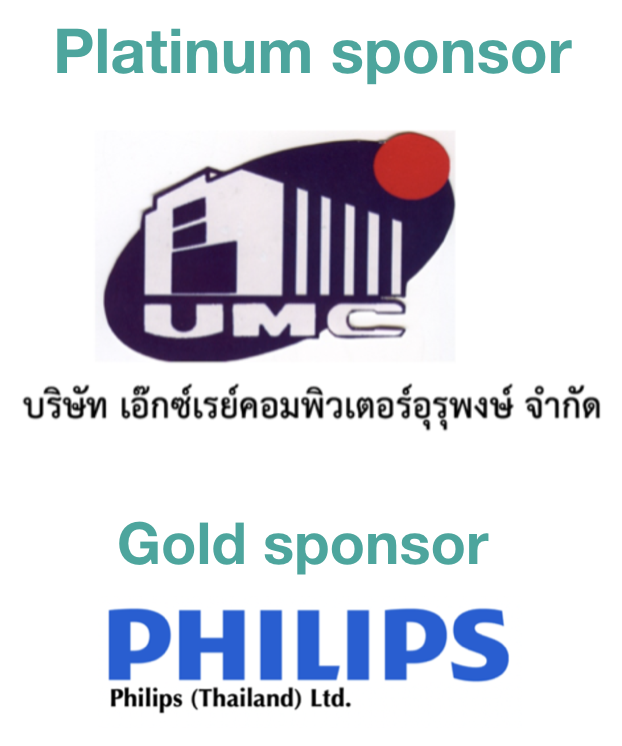Factors affecting size-specific dose estimates in addition to scanning parameters for chest-abdomen-pelvis computed tomography using automatic tube current modulation at Chiangrai prachanukroh hospital
Keywords:
Arm position, Automatic tube current modulation, Computed tomography, Patient off-centering, Size-specific dose estimatesAbstract
Background: Computed tomography (CT) is a high radiation dose modality in diagnostic radiology. In addition to the scanning parameters, there are other factors affecting patient radiation dose. Objective: To study the factors in addition to scanning parameters that may affect size-specific dose estimates (SSDE). Methods: This study was a retrospective observational cross-sectional design in the patients who underwent Chest-Abdomen-Pelvis CT using automatic tube current modulation between September 2019 and June 2020 at Chiangrai prachanukroh hospital (CRH). Five hundred thirty-five patients were divided into 5 groups based on water-equivalent diameter (Dw) and then patients in each group were divided into 2 subgroups: SSDE being greater than the median and SSDE not being greater than the median. A cut-off value was the median SSDE of each Dw group. The variables of interest (gender, age, effective diameter, scan projection radiography (SPR) view, arm position, presence of foreign bodies or medical devices and patient off-centering) were compared between the group with SSDE being greater than the median and the group with SSDE not being greater than the median. Results: Female, younger than 60 years old and effective diameter were associated with the significantly increased likelihood of SSDE being greater than the median (p-value<0.05). The presence of foreign bodies or medical devices were associated with the borderline significantly increased likelihood of SSDE being greater than the median (p-value=0.050). The likelihood of SSDE being greater than the median, in arm-down position on SPR and then repositioning to be arm up position on the axial images was not statistically significantly different from non-reposition (arm down position on both SPR and axial images), but both of these were statistically significantly associated with the higher likelihood compared with the arm up position on both SPR and axial images. The SPR view and patient off-centering were no statistically significant associations with the SSDE being greater than the median. Conclusions: Female, younger than 60 years-old, effective diameter, presence of the foreign body or medical devices and arm down position on the SPR had an effect on higher SSDE than the median.
Downloads
References
International Atomic Energy Agency (IAEA). Dose reduction in CT while maintaining diagnostic confidence: a feasibility/demonstration study [Internet]. 2009 [cited 2019 Oct 2]. Available from: https://www-pub.iaea.org/MTCD/Publications/PDF/te_1621_web.pdf
Brenner DJ, Hall EJ. Computed tomography--an increasing source of radiation exposure. N Eng J Med. 2007;357(22):2277-84. doi: 10.1056/NEJMra072149. PMID: 18046031.
ศุภวิทู สุขเพ็ง. ระบบควบคุมปริมาณกระแสหลอดในเครื่องเอกซเรย์คอมพิวเตอร์: หลักการทำงานและปัจจัยที่มีผลต่อปริมาณรังสี. สงขลานครินทร์เวชสาร [อินเทอร์เน็ต]. 2558 [เข้าถึงเมื่อ 2563 มกราคม 23];33(4):[หน้า 197-206]. เข้าถึงได้จากhttps://medinfo.psu.ac.th/smj2/33_4_2015/5_suppawitoo.pdf
Kalender WA. Dose in x-ray computed tomography. Phys Med Biol. 2014;59(3):R129–50. doi: 10.1088/0031-9155/59/3/R129. PMID: 24434792.
American Association of Physicists in Medicine (AAPM). Size-specific dose estimates (SSDE) in pediatric and adult body CT examination: AAPM report no. 204 [Internet]. 2011 [cited 2018 Oct 30]. Available from: https://www.aapm.org/pubs/reports/RPT_204.pdf
American Association of Physicists in Medicine (AAPM). Use of water equivalent diameter for calculating patient size and size-specific dose estimates (SSDE) in CT: AAPM report no. 220 [Internet]. 2014 [cited 2018 Oct 30]. Available from: https://www.aapm.org/pubs/reports/rpt_220.pdf
Matsubara K, Koshida K, Ichikawa K, Suzuki M, Takata T, Yamamoto T, et al. Misoperation of CT automatic tube current modulation systems with inappropriate patient centering: phantom studies. AJR Am JRoentgenol. 2009;192(4):862-5. doi: 10.2214/AJR.08.1472. PMID: 19304687.
Kaasalainen T, Palmu K, Reijonen V, Kortesniemi M. Effect of patient centering on patient dose and image noise in chest CT. AJR Am J Roentgenol. 2014;203(1):123-30. doi: 10.2214/AJR.13.12028. PMID: 24951205.
Singh S, Petrovic D, Jamnik E, Aran S, Pourjabbar S, Kave ML, et al. Effect of localizer radiograph on radiation dose associated with automatic exposure control: human cadaver and patient study. J Comput Assist Tomogr. 2014;38(2):293-8. doi: 10.1097/RCT.0000000000000035. PMID: 24632938.
Peng W, Li Z, Xia C, Guo Y, Zhang J, Zhang K,et al. A CONSORT-compliant prospective randomized controlled trial: radiation dose reducing in computed tomography using an additional lateral scout view combined with automatic tube current modulation: Phantom and patient study. Medicine (Baltimore). 2017;96(30):e7324. doi: 10.1097/MD.0000000000007324. PMID: 28746180.
Brink M, de Lange F, Oostveen LJ, Dekker HM, Kool DR, Deunk J, et al. Arm raising at exposure-controlled multidetector trauma CT of thoracoabdominal region: higher image quality, lower radiation dose. Radiology. 2008; 249(2):661-70. doi: 10.1148/radiol.2492080169. PMID: 18936319.
Ryu YJ, Choi YH, Cheon JE, Park JE, Kim WS, Kim IO. Effect of arm position, presence of medical devices, and off-centering during acquisition of scout image on automatic tube voltage selection and current modulation in pediatric chest CT. PLoS One. 2018;13(4): e0195807. doi: 10.1371/journal.pone.0195807. PMID: 29664918.
Kanal KM, Butler PF, Sengupta D, Bhargavan-Chatfield M, Coombs LP, Morin RL. U.S. diagnostic reference levels and achievable doses for 10 adult CT examinations. Radiology. 2017;284(1):120-33. doi: 10.1148/radiol.2017161911. PMID: 28221093.
Choudhary N, Rana BS, Shukla A, Oinam AS, Singh NP, Kumar S. PATIENTS DOSE ESTIMATION IN CT EXAMINATIONS USING SIZE SPECIFIC DOSE ESTIMATES. Radiat Prot Dosimetry. 2019;184(2):256–62. doi: 10.1093/rpd/ncy207. PMID: 30496523.
Barreto I, Verma N, Quails N, Olguin C, Correa N, Mohammed TL. Patient size matters: Effect of tube current modulation on size-specific dose estimates (SSDE) and image quality in low-dose lung cancer screening CT. J Appl Clin Med Phys. 2020;21(4):87-94. doi: 10.1002/acm2.12857. PMID: 3225006
Anam C, Haryanto F, Widita R, Arif I, Dougherty G. A fully automated calculation of size-specific dose estimates (SSDE) in thoracic and head CT examinations. J. Phys.: Conf. Ser. 2016;694:012030. doi: 10.1088/1742-6596/694/1/012030.
Rizzo S, Kalra M, Schmidt B, Dalal T, Suess C, Flohr T, et al. Comparison of angular and combined automatic tube current modulation techniques with constant tube current CT of the abdomen and pelvis. AJR Am J Roentgenol. 2006;186(3):673-9. doi: 10.2214/AJR.04.1513. PMID: 16498094.
Svahn TM, Peric L, Ast JC. Influence of different arm positions in the localizer radiograph(s) on patient dose during exposure-controlled CT examinations of the neck to pelvis. Tomography 2021;7(3):313-22. doi: 10.3390/tomography7030028.
Bayer J, Pache G, Strohm PC, Zwingmann J, Blanke P, Baumann T, et al. Influence of arm positioning on radiation dose for whole body computed tomography in trauma patients. J Trauma. 2011;70(4):900-5. doi: 10.1097/TA.0b013e3181edc80e.
Lambert JW, Kumar S, Chen JS, Wang ZJ, Gould RG, Yeh BM. Investigating the CT localizer radiograph: acquisition parameters, patient centering and their combined influence on radiation dose. Br J Radiol. 2015;88(1048):20140730. doi: 10.1259/bjr.20140730. PMID: 25608494.
Harri PA, Moreno CC, Nelson RC, Fani N, Small WC, Doung PA, et al. Variability of MDCT dose due to technologist performance: impact of posteroanterior versus anteroposterior localizer image and table height with use of automated tube current modulation. AJR Am J Roentgenol. 2014;203(2):377-86. doi: 10.2214/AJR.13.11608. PMID: 25055274.
Cluny L, Gillen R, MacDonald N. Optimisation of CT scan planar radiographs [Internet]. [Cited 2021 May 12]. Available from: https://ctug.org.uk/meet17-10-19/Optimisation%20of%20CT%20Scan%20Planar%20 Radiographs.pdf
Svahn TM, Ast JC. EFFECTIVE DOSE AND EFFECT OF DOSE MODULATION FOR LOCALIZER RADIOGRAPHS USING APPLIED AND ALTERNATIVE SETTINGS ON TOSHIBA/CANON CT SYSTEMS. Radiat Prot Dosimetry. 2021;195(3-4):198-204. doi: 10.1093/rpd/ncab030. PMID: 33851201.
Barreto I, Lamoureux R, Olguin C, Quails N, Correa N, Rill L, et al. Impact of patient centering in CT on organ dose and the effect of using a positioning compensation system: Evidence from OSLD measurements in postmortem subjects. J Appl Clin Med Phys. 2019;20(6):141-51. doi: 10.1002/acm2.12594. PMID: 31050136.
Zhang D, Ayala R. Auto couch height positioning compensation – making SUREExposure a smarter dose reduction tool. Tustin, CA: Toshiba American Medical System; 2014 [cite 2020 May 11]. Available from: https://us.medical.canon/download/ct-aq-one-fam-wp-sureexposure
Merzan D, Nowik P, Poludniowski G, Bujila R. Evaluating the impact of scan settings on automatic tube current modulation in CT using a novel phantom. Br J Radiol. 2017;90(1069):20160308. doi: 10.1259/bjr.20160308. PMID: 27845559.

Downloads
Published
How to Cite
Issue
Section
License
Copyright (c) 2022 The Thai Society of Radiological Technologists

This work is licensed under a Creative Commons Attribution-NonCommercial-NoDerivatives 4.0 International License.
บทความที่ได้รับการตีพิมพ์เป็นลิขสิทธิ์ของสมาคมรังสีเทคนิคแห่งประเทศไทย (The Thai Society of Radiological Technologists)
ข้อความที่ปรากฏในบทความแต่ละเรื่องในวารสารวิชาการเล่มนี้เป็นความคิดเห็นส่วนตัวของผู้เขียนแต่ละท่านไม่เกี่ยวข้องกับสมาคมรังสีเทคนิคแห่งประเทศไทยและบุคคลากรท่านอื่น ๆในสมาคม ฯ แต่อย่างใด ความรับผิดชอบองค์ประกอบทั้งหมดของบทความแต่ละเรื่องเป็นของผู้เขียนแต่ละท่าน หากมีความผิดพลาดใดๆ ผู้เขียนแต่ละท่านจะรับผิดชอบบทความของตนเองแต่ผู้เดียว




